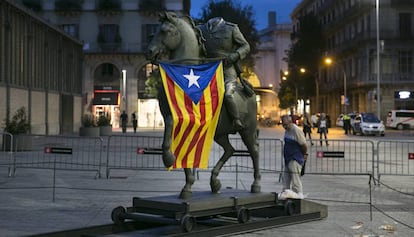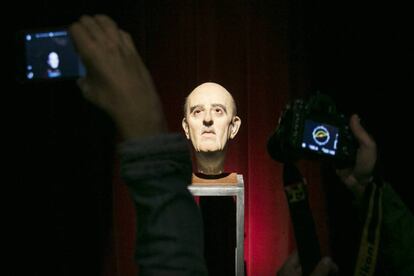Fists fly as new Franco exhibition opens in Barcelona
Protesters disrupt controversial show looking at legacy of dictator in Catalan capital

More than 40 years after his death, General Francisco Franco is still capable of stirring up controversy in Spain, as the opening of a new exhibition in Barcelona this week shows.
Protests, pushing and shoving, the throwing of eggs and rotten fruit, and even a fist fight between two middle-aged men all featured on Monday when the new “Franco, Victory, Republic and Impunity in Urban Spaces” show opened at Barcelona’s Born Center for Culture and Memory (BCCM).
The catalyst for the drama was the presence on the street outside the exhibition venue of two statues of the right-wing dictator, who ruled Spain for nearly four decades in the wake of a bitter and bloody civil war.
Many streets and buildings in Spain still have names linked to Franco’s dictatorship
The two statues – an equestrian likeness of the leader by Josep Viladomat, which has been headless since vandals attacked it in 2013, and a work known as The Victory by Frederic Marès, which commemorates the triumphant entry of Franco into Barcelona in 1939 – are key pieces in an exhibition that aims to ensure people “never forget what has happened,” according to Barcelona Deputy Mayor Gerardo Pisarello, who spoke at the opening of the exhibition on Monday night.
His words were drowned out, however, by a small but noisy group of protesters who attempted – without success – to put a stop to the exhibition opening with shouts and jeers.
Moments before the inauguration of the show, which was boycotted by the pro-independence ERC and CiU political parties, a fight broke out between two men. They eventually had to be separated. Meanwhile, 25 people slowly marched around the museum carrying black signs inscribed with the names of family members killed during Franco’s regime.
Two small groups of left-wing activists also managed to make their way past security personnel and to the two sculptures, where they held up posters reading: “Franco – not in Born or anywhere else,” and: “Get Franco out of the streets”.
“We wanted to this be a sober, austere exhibition, almost arte povera,” said show organizer Manel Risques, referring to the radical art movement of the 1960s and 1970s that saw artists attacking the established order.

“It is a reflection on the two occasions when Barcelona was destroyed – in 1714 [when Philip V laid siege to the city during the War of Spanish Succession] and 1939, and who collaborated, who was accepting and who was in active opposition,” said Risques.
The exhibition, held at a venue considered the ground zero of Catalonia’s independence movement, includes press clippings, documents and photographs from different periods. These show the persistence of symbols of the Franco era in Spain decades after the country returned to democracy and examines the impunity those symbols have enjoyed.
Among the most striking pieces is a silicon hyperrealist head of Franco created by Spanish artist Eugenio Merino, who told EL PAÍS he would have liked to place his artwork on top of the decapitated equestrian statue.
But the current exhibition is also part of a larger dialogue in Spain about how the country should deal with its difficult past. Most statues of Franco were taken down a long time ago but controversy still rages over streets and buildings that retain names linked to the dictatorship. Forty years after the death of the dictator, there are still streets named after generals who led the military uprising.
The exhibition opening included protests, the throwing of eggs and rotten fruit, and even a fist fight
In 2007, the Socialist government of former Prime Minister José Luis Rodríguez Zapatero passed the Historical Memory Law, granting subsidies to projects such as the opening of mass graves from the Civil War.
It also took into account the removal of statues and the changing of place names connected to the Franco regime. But funding was slashed when the conservative Popular Party (PP) arrived in power in 2011, halting such projects throughout Spain.
Risques points out that the two statues at the entrance to the exhibition were only removed from their original homes a few years ago. The equestrian statue was taken down from Barcelona’s Montjuïc in 2008 while the statute known as The Victory was in place until 2011.
That prompted Risques to question the real attitude of previous administrations toward symbols of Franco on the streets of the city. He also challenges those who have been so incensed by the exhibition to explain why those symbols weren’t removed earlier. “Maybe they were sitting on the sofa at home,” he said ironically.
English version by George Mills.
Tu suscripción se está usando en otro dispositivo
¿Quieres añadir otro usuario a tu suscripción?
Si continúas leyendo en este dispositivo, no se podrá leer en el otro.
FlechaTu suscripción se está usando en otro dispositivo y solo puedes acceder a EL PAÍS desde un dispositivo a la vez.
Si quieres compartir tu cuenta, cambia tu suscripción a la modalidad Premium, así podrás añadir otro usuario. Cada uno accederá con su propia cuenta de email, lo que os permitirá personalizar vuestra experiencia en EL PAÍS.
¿Tienes una suscripción de empresa? Accede aquí para contratar más cuentas.
En el caso de no saber quién está usando tu cuenta, te recomendamos cambiar tu contraseña aquí.
Si decides continuar compartiendo tu cuenta, este mensaje se mostrará en tu dispositivo y en el de la otra persona que está usando tu cuenta de forma indefinida, afectando a tu experiencia de lectura. Puedes consultar aquí los términos y condiciones de la suscripción digital.
More information
Últimas noticias
Pinochet’s victims grapple with José Antonio Kast’s rise in Chile
Reinhard Genzel, Nobel laureate in physics: ‘One-minute videos will never give you the truth’
How Japan is trying to avert ‘digital defeat’
The complicated life of Francesca Albanese: A rising figure in Italy but barred from every bank by Trump’s sanctions
Most viewed
- Pablo Escobar’s hippos: A serious environmental problem, 40 years on
- Why we lost the habit of sleeping in two segments and how that changed our sense of time
- Charles Dubouloz, mountaineering star, retires at 36 with a farewell tour inspired by Walter Bonatti
- Trump’s obsession with putting his name on everything is unprecedented in the United States
- The Florida Keys tourist paradise is besieged by immigration agents: ‘We’ve never seen anything like this’











































